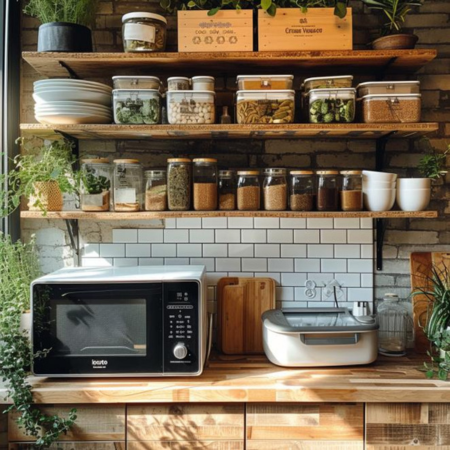As the eco-friendly wave sweeps across the globe, ‘compostable containers’ are becoming the new buzzword in sustainable living.
But let’s face it, in today’s fast-paced world, convenience matters too. We’re all guilty of the occasional (or frequent) zap in the microwave to reheat our leftovers.
So, can you microwave compostable containers? Will they maintain their integrity, or is it a one-way ticket to a messy disaster?
Stick around as we unravel the mysteries surrounding microwaving compostable containers, the science behind their composition, and guidelines for their safe use. Save the planet, one container at a time, without sacrificing a bit of your convenience!
Key Points
- Compostable containers are designed to break down in a compost heap.
- Not all compostable containers can withstand microwave temperatures.
- Microwaving can sometimes accelerate the decomposition process of these containers.
- Always check for ‘microwave-safe’ labels before using compostable containers.
- Using compostable containers responsibly contributes to sustainable living practices.
Can You Microwave Compostable Containers
In general, compostable containers are not recommended for microwaving. Here’s why.
First, we need to understand the materials used. Compostable containers are made from plant-based materials. They are designed to break down in composting conditions. That’s their eco-friendly advantage.
Microwaving them, however, can be a problem. High heat and radiation can cause these containers to warp or melt. When that happens, your food might become contaminated. That’s not something you want.
So how can you tell if your container is microwave-safe? Some brands might label their containers as such. But remember, these claims need to be backed by proper testing. Without that, it’s best to avoid the risk.
Now, you might wonder, “What about containers labeled as ‘microwavable compostable’?” Good question. Yes, they exist. But they’re not as common. These containers are specially made to withstand the heat of a microwave. But again, always look for proper certification.
In conclusion, microwaving compostable containers is a risky endeavor. It’s better to transfer food to a microwave-safe dish instead. This way, you ensure both your health and the container’s compostability are not compromised.
The Science Behind Compostable Containers
Compostable containers are unique. They’re made from plant-based materials like corn, sugar cane, and wheat straw. These materials are renewable and decompose naturally in a composting environment. That’s a win for the environment! But how does all this work?
Each plant-based material has its properties. They contain molecules called polymers. Under the right conditions, microorganisms digest these polymers. The process is called biodegradation. The result? Nutrient-rich compost!

But, the properties that make these containers compostable create a challenge. Heat and microwave radiation can cause them to deform or even melt. When this happens, contaminants could leach into your food. Not a pleasant thought.
The solution? Special ‘microwave-safe‘ compostable containers. They contain additional materials to withstand heat. But, they’re not common and can be more expensive.
The rule of thumb? Always check for certifications. Trustworthy brands will have their products tested and certified. This ensures they are truly compostable and microwave-safe if labeled so. Without these, it’s risky.
The best practice is to avoid microwaving compostable containers when in doubt. Transfer your food to a microwave-safe dish instead. This way, you protect both your health and the environment. Happy microwaving!
4 Potential Risks Of Microwaving Compostable Containers
Microwaving compostable containers do carry potential risks. Here are some of them in detail:
- Chemical Leaching: As mentioned, compostable containers could deform under high heat. This deformation can result in chemical leaching from the container to your food. It could be harmful if consumed.
- Inadequate Heating: Compostable containers may not heat food evenly. This can potentially lead to foodborne illnesses if certain parts of your food are not adequately heated.
- Fire Hazard: If compostable containers get too hot, they might even catch fire. This can pose serious safety risks.
- Cost and Availability: Compostable microwave-safe containers are more expensive than their non-compostable counterparts. They may also be harder to find in stores.
Now, let’s delve a bit deeper into these risks.
Chemical leaching is a serious concern. When containers melt or deform, they can release harmful substances. These substances may contaminate your food. Regular consumption can lead to health issues.
Uneven heating can lead to undercooked food. Certain bacteria can survive if the food isn’t heated properly. This may lead to food poisoning.
A fire hazard is self-explanatory. If a container catches fire in your microwave, it can cause significant damage. Not just to your microwave, but to your home.
Lastly, cost and availability present practical concerns. If microwave-safe compostable containers are pricy or hard to find, people are less likely to use them. This can hinder the adoption of these environment-friendly alternatives.
Guidelines For Safe Use Of Compostable Containers In Microwaves
Before you microwave food in compostable containers, ensure the container is marked as microwave-safe. Not all compostable containers are designed to withstand microwave heat.
Look for labels on the container. Symbols or text indicating microwave safety are crucial. If no such indicators are present, don’t risk it.
Never microwave an empty compostable container. The heat from the microwave can cause the container to deform or catch fire. Always ensure there’s food or liquid in the container to absorb the microwave energy.
Avoid heating food to extremely high temperatures in compostable containers. The high heat can cause the container to deform and possibly leach chemicals into your food.
Use a microwave-safe cover if the food needs to be covered while microwaving. Don’t use plastic wrap as a cover. It can melt onto the container and into your food.
Rotate the container halfway through the heating time. This helps to distribute heat evenly, which is particularly important when using compostable containers.
Keep a close watch on the microwave when using compostable containers. Turn off the microwave immediately if you notice any smoke or smell something burning.
Remember, compostable containers are more expensive and less widely available than regular microwave-safe containers. Consider this before making them your go-to option for heating food.
Following these guidelines, you can safely use compostable containers in the microwave. This way, you’re protecting your health and contributing to environmental conservation.
Making A Difference: Compostable Containers And Sustainable Living
Compostable containers are game-changers in the world of sustainable living. They promote a circular economy, where waste becomes a resource. This reduces the strain on our landfill sites and decreases the overall carbon footprint.
Compared to their plastic counterparts, compostable containers decompose into non-toxic components. They return nutrients to the soil. This makes them an eco-friendly solution for our kitchen waste management.
However, it’s not just about the end of the product’s life. The manufacturing process of compostable containers also matters. It typically requires less energy than plastic production. This results in fewer greenhouse gas emissions.

Furthermore, the raw materials for compostable containers often come from renewable sources. These include corn, sugarcane, and other plant-based materials. Supporting these products also means supporting sustainable agriculture.
But remember, compostable doesn’t always mean biodegradable. Not all compostable goods will decompose in your backyard compost pile. Some need industrial composting facilities to break down. So, it’s also crucial to know your local waste management system.
In this era of environmental consciousness, every little step counts. Switching to compostable containers may seem insignificant.
But if we all took this step, it could lead to a considerable reduction in waste. Every effort contributes to a healthier and more sustainable planet for future generations.
Let’s embrace compostable containers and make a difference.
Frequently Asked Questions
FAQ 1: What are the benefits of compostable containers?
Compostable containers have several advantages. First, unlike plastic containers, they decompose into non-toxic components and return nutrients to the soil. Also, making compostable containers usually requires less energy than producing plastics, resulting in fewer greenhouse gas emissions. Moreover, the raw materials for these containers often come from renewable sources, which aids in promoting sustainable agriculture.
FAQ 2: What are compostable containers made from?
Compostable containers are often made from plant-based materials such as corn and sugarcane. These renewable sources make the containers an eco-friendly alternative to traditional plastic containers.
FAQ 3: What’s the difference between compostable and biodegradable?
While all compostable items are biodegradable, not all biodegradable items are compostable. Compostable goods decompose into nutrient-rich soil in a composting setting, but some may require industrial composting facilities to break down due to their makeup.
FAQ 4: What is the importance of understanding the local waste management system?
Understanding local waste disposal systems is crucial since not all compostable goods will decompose in a backyard compost pile. Some of them need to be processed in an industrial composting facility. Knowing the local waste management system helps dispose of compostable containers correctly.
FAQ 5: How does compostable containers contribute to a more sustainable planet?
Compostable containers can significantly reduce the waste that goes to landfill sites and decrease the overall carbon footprint. Plus, each step taken towards using compostable containers supports sustainable agriculture and reduces greenhouse gas emissions, contributing to the well-being of future generations.
Conclusion
In conclusion, compostable containers play a crucial role in promoting environmental sustainability.
Made from renewable resources, they support sustainable agriculture while offering an eco-friendly alternative to traditional plastic.
Understanding the nuances between compostable and biodegradable products and the workings of the local waste management system is key to making informed decisions.
By choosing compostable containers, we move a step closer to reducing our carbon footprint, minimizing waste sent to landfills, and ensuring a healthier planet for future generations.
- Can You Microwave Whiskey: 8 Alternative Methods - April 28, 2024
- Can You Put A Crock Pot In The Microwave: 4 Safety Tips - April 27, 2024
- Can You Microwave Wax Beads: 8 Easy Steps - April 26, 2024

